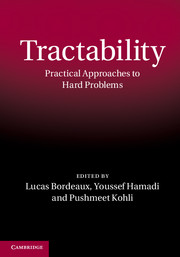Introduction
Published online by Cambridge University Press: 05 February 2014
Summary
In mathematics and computer science, optimization is the process of finding the best solution from a set of alternatives that satisfy some constraints. Many applications in allied fields of computer science like machine learning, computer vision, bioinformatics, involve the solution of an optimization problem. For instance, optimization is used to schedule trains and airplanes, allocate the advertisements we see on television or in connection with internet search results, ind the optimal placement of sensors to detect and neutralize security threats, or even to make decisions on what is the best way to perform medical surgery on a patient.
Optimization problems are generally hard to solve – their solution may involve exhaustively searching over a set of solutions whose size could increase exponentially with the number of variables whose values we may want to infer. That said, in practice, many of these problems can often be solved with remarkable efficiency. This is usually done by dedicated techniques, developed in each and every application domain, that exploit the “properties” of the problems encountered in practice.
Over the last few decades, researchers working in a number of different disciplines have tried to solve optimization problems that are encountered in their respective ields by exploiting some structure or properties inherent in the problems. In some cases, they have been able to isolate classes of optimization problems that can be solved optimally in time polynomial in the number of variables, while in other cases, they have been able to develop efficient algorithms that can produce solutions that, although not optimal, are good enough.
- Type
- Chapter
- Information
- TractabilityPractical Approaches to Hard Problems, pp. xiii - xxiiPublisher: Cambridge University PressPrint publication year: 2014



